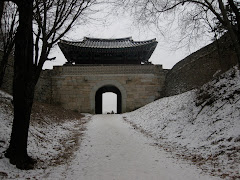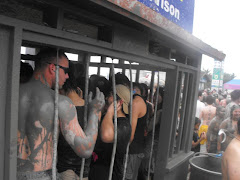First of all, many have expressed concern over the unpredictable Kim Jong Il to the North. As I have stated before in previous posts, this is not as big a deal 200 km to the South as it is made out to be via Western media sources. Honestly speaking, South Koreans are numb to the various threats and North Korean chest pumping which has occurred over the past 50 years. To them, it's old rhetoric. It's also important to remember that many still wish for a reunited Korea, though most people I speak with do not think this is possible in today's world. Their reasons are mainly economic, citing the numerous financial issues exemplified by the unification of East & West Germany twenty years ago, and some language and cultural differences which have evolved over 50 years of separation.
So, need not fear about North Korea. American and U.N. forces will most assuredly pummel the North should any type of military situation escalate. As a precaution I have registered my presence with the American Embassy here in South Korea, so I receive the American Citizen Services emails concerning important information, etc. Should any type of emergency arise, my cell phone is also registered with the embassy to assure prompt evacuation of the country. Or so they say.
Korean Starbucks is just like any other Starbucks in the U.S., but in decor and ambiance only. The menu is totally different, each cup of coffee is individually brewed, prices are more expensive, and you must input your foreigner ID number to access the free internet. Green tea lattes are a delicious treat, and should be featured in the U.S. stores. There are no coffee refills. Instead, you purchase a second cup of coffee at the same price as the first. Orders take an exceptionally long time to fill, and once ready, the baristas call out the order in Korean so if you are a foreigner you have no idea if it is your order or not. If you do not respond to their bellowing within 20-30 seconds, they will repeat their calls several times with more intensity and volume. If you do not claim your order within 1-2 minutes, they will soon find you, and when they do, their look suggests they do not like to leave the counter area to locate your sorry ass. Oh, and by the way, your order remains at the counter. You must follow them back to retrieve it.
It is rare to find a Korean public restroom with soap, towels or hand dryer, and toilet paper. Seriously. I read this prior to U.S. departure so I was well prepared, and I even purchased a portable toilet paper carrier for such occasions. I am pleased to announce, this purchase has paid for itself on a few occasions. Sometimes, restaurants may provide community style toilet paper at the front door, but you must determine the amount you will require prior to leaving for your toilet adventure. Restaurants and other businesses typically do not have their own restrooms, so you usually have to locate a restroom that is shared by multiple tenants in a building. Korean public restrooms are usually not clean, so it is an adventure in every sense of the word. Sometimes there is no toilet seat. Instead, you must hover above the hole in the ground in a squatting position until your business is finished. This is most uncomfortable and I suggest avoiding whenever possible. So, it's best to familiarize yourself with the local geography and always know where 1) the restrooms are located, and 2) the best restrooms are located.
Restaurants also do not provide napkins. Instead, a wet towel is often provided when you first sit at the table, and there is a small tissue dispenser at the table. Korean restaurants feature something that should be found in every restaurant; a buzzer to signal the waitstaff attention. This, combined with the fact that tipping is not customary, is perhaps the greatest part of Korean dining and makes it so service-friendly and inexpensive to dine out. The unfortunate part of this as a foreigner, is that it can be difficult to read and understand the menu, assuming that an English version is not available or there are no pictures. Substitutions or special requests are virtually impossible unless, of course, the waitress speaks English. Not every restaurant requires you to remove your shoes and sit on the floor. In fact, many restaurants feature both sit on the floor and upright seating sections. The floor seating, usually, is great for the first half of the meal until the lack of back support begins to interfere with your comfort. Because of this, I suggest the sit down seating unless your floor area backs up to a wall.
Korean food is very delicious. I have read many articles that suggest it is one of the most under-appreciated worldwide cuisines, and in fact, the Korean government has recently began a $40 million initiative to increase awareness of Korean cuisine. Their goal is to quadruple the number of Korean restaurants worldwide by 2017. Fresh vegetables and a variety of meats and seafood are the staple ingredients, along with generous portions of many spices including garlic, red pepper, ginger, soy sauce, vinegar, and sesame oil. Steamed rice accompanies nearly every meal, as do the numerous side dishes (banchan) consisting of kimchi, and as many as 10-12 different types of soup, vegetables, seaweed, pickled fruits, etc.
In my short three months here, I have only encountered a handful of dishes I did not enjoy. Also, other than dried silkworm larvae and live squid, there really are no outrageously gross or disgusting foods. Most dishes are very flavorful and many, but not all, are relatively spicy. Almost all Korean food is eaten with chopsticks (jeut ga rak) and/or a spoon (sut ga rak). Fried chicken is very popular here, though I must admit, it's hit or miss to locate good fried chicken. Most places serve small pieces with lots of bones and little meat on them. There are chicken and hof (beer on tap) restaurants located throughout Korea, and there is a Popeyes Chicken located in the Sanbon subway station. Korean pizza, including Pizza Hut, Dominos, and Papa Johns feature many strange toppings and sauces. Cheese stuffed crust is big, though, as is a sweet potato crust, which is not half bad. A plain pepperoni pizza can be expensive (15-20,000 Won), and because Koreans do not like greasy foods, the cheese is very light. Korean beef is expensive, so most places feature Australian beef.
Alcohol is a major part of Korean culture. The ability to drink lots is considered a big thing in Korea. In fact, business students informed me that Korean contact management software have a tool to record a person's alcohol tolerance as a part of their customer records. No joke. It's that important in Korean society, and apparently, also in business. Noraebang is also considered a somewhat mandatory trip when entertaining for business. Many people will ask you how much alcohol you can drink when they first meet you. It's a kind of Confucian thing, putting you into a group upon first encounter, and always curious to learn about the foreigner. Mak-ju (beer), soju, and makgeolli are most popular here. Draft beers are maybe 3,000-8,000 Won depending on the type of beer and the the bar. Cass, OB, Hite, and Max are all popular Korean beers, and each taste similar to your average American pilsner (e.g. Budweiser, Miller, Coors, etc.). Black Beer Stout has become one of my favorite domestic beers, and in addition to being inexpensive compared with other beers, it tastes similar to Michelob Amberbach. Guiness Stout can be found here, but it is expensive at 8-9,000 Won per pint. Soju and makgeolli are very inexpensive (2,000-4,000 Won), and mixed drinks/cocktails are increasingly popular, though they can be very expensive (7,000-10,000+ Won). Soju and makgeolli are almost always shared, and you never pour your own drink. You may pour alcohol for everyone at the table, but someone else must pour your glass.
Because Korea is an honorific society, you should always bow to your elders and use two hands when pouring their drinks. This can be done with one hand placed across the chest or with the free hand touching the arm of the pouring hand. If an elder happens to pour your drink for you, you should use two hands to hold the glass and accept the drink, along with a slight bow. While this is not necessary with water, it is preferred with most other beverages and a must with alcohol. The bow is a small bow, almost an exaggerated head nod, and is not held in position like the Japanese custom. It is, in fact, a quick nod.
Communication with Koreans is, obviously, difficult at times. It is rare treat to find a Korean who can speak good English, and is willing to overcome their hesitation to speak with a foreigner. Sometimes, the occasional mispronunciation or incorrect spelling of a word can be awkward or most humorous. Example: Korean student invited me to attend a baseball game with him "Sunday." After gladly accepting his invitation and asking him repeatedly "what time Sunday" we eventually realized he meant to say, "someday", thus no need for a precise time and no baseball game Sunday. Another example: English teacher friend in Sanbon told me a funny story last week. His students were asked to provide different scenarios for class dialogue. Unfortunately, "don't give her too much cock" was mistaken for "coke" by his young student. Ouch!
Most Koreans really are awful drivers. Noodle delivery men on scooters are the very worst, and bus drivers, truck drivers, and taxi drivers are not far off. There does not seem to be any regard for traffic lights or any consequence for running them. Looking both ways prior to crossing the street is a definite must, as is wearing seat belts whenever possible. Koreans also like the over-exaggerated use of the horn. I commonly hear this outside my apartment window from the alley below, and it can be highly frustrating in the early morning hours or when the horns continue for what seems like minutes at a time.
The Seoul Metro subway system is a convenient way to travel the 20 some kilometers from my home in Sanbon to central Seoul. Depending on where I travel in Seoul, it takes me between 40 minutes to 1 hour 10 minutes. Incheon (Seoul International Airport) and other Northern parts of Seoul can be 1 hour 30 minutes to 2 hours travel time. Cost is between 800-2,000 Won depending on the distance, and is paid using my T-Money card, which also can be used on city buses and when traveling via taxi. I usually reload the card with 10,000 Won every two weeks, depending on my travels. While people watching can be a great way to pass the time, I suggest bringing a book and iPod to make the trip more enjoyable. Korean cell phone games are another good way to pass the time. I especially enjoy the sudoku, ZooZoo Club (a type of tetris), and golf game my phone features. Some Koreans, and at least one American, will use this opportunity for a short nap. The difficulty, naturally, is waking before your stop.
Also, a seat on the subway is a major score. Most times I am not so lucky and usually end up standing, if not for the entire trip, then most of it. There are a total of nine subway lines intersecting throughout the Seoul metropolitan area, and changing trains is relatively painless. Be prepared to walk though, as some stations are very large and spread out. Almost all are well marked in English, so that is never an issue. Station exits, usually at least four, are also marked in English so you know where to exit and what direction to head. The biggest drawback to the transit system are the hours. The train only runs until 1am during the week and 12am on the weekends. This makes bar/club hopping in Seoul almost impossible, unless of course, you plan on spending the night out on the town or at a NoraeBang somewhere in Seoul. The bars/clubs, by the way, are open until 5 or 6am, exactly when the trains resume morning operations.
Despite the many cultural differences mentioned above, I have found there are many similarities between Korean and Western cultures. For example, the Korean divorce rate is constantly rising and is currently around 30%. One of the biggest reasons for this is many Korean women now possess multiple college degrees and are more career focused. This, obviously, is a break from the past traditions where the women stay at home only to provide for the men and children. Interestingly, Koreans do not make public if they become divorced. It's a kind of shameful secret amongst their friends, colleagues and neighbors. Adultery has also become a recent fad here in Korea, though I have read it is illegal, and both consenting parties can be prosecuted for this. Koreans, it would seem, mimic Western cultures and are sometimes 5-10 years behind many American trends. Another example; cosmetic surgery is increasingly popular, with some 30% of college students seeking this. One of the most popular procedures is the double eye lid, something many Korean women find desirable.
What is also interesting is that many Koreans are plagued by the same troubles or difficulties facing many American people. In other words, parents easily get frustrated with their children, people suffer from stress, families worry about their finances, and Korean men will complain about their bosses and their wives, etc. A popular debate currently stemming in Korea is euthanasia and the right to die/death with dignity for elderly and terminally ill patients. This topic makes for excellent in-class debate with the students, and the overwhelming response is in support of this. Another good debate is private education versus public education, as the Korean educational system is currently plagued with many harsh criticisms. Koreans, it would seem, are amongst the most exam obsessed people in the world, and spent an estimated 20 trillion Won (almost $20 billion U.S.D.) on private education in 2006, of which, half was spent on English education. Yet another amazing fact; Korean schoolchildren age elementary through high school study from 8am until 10pm daily, with few breaks.
I hope this is helpful. Please let me know if you you have any specific questions or want to learn more about any one subject. Also, I would suggest looking at some of the Korean articles featured in the right side column of this blog. I have used many of these articles in classes, and almost all provide a detailed look into Korean life, traditions, travel, politics, the economy, and other interesting and insightful matters.
Enjoy!

























































































































































1 comment:
ethan, i am truly amazed by the depth of your knowledge regarding the korean people, culture, foods, political and social issues, geography, etc. it is obvious you have really put a lot of time and effort into learning abt. these areas - you sound like a professor!!!
Post a Comment